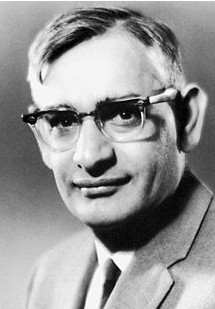
Har Gobind Khorana
usinfo | 2012-12-05 16:00

Har Gobind Khorana also known as Hargobind Khorana (January 9, 1922 – November 9, 2011) was an Indian-born American biochemist who shared the 1968 Nobel Prize for Physiology or Medicine with Marshall W. Nirenberg and Robert W. Holley for research that helped to show how the nucleotides in nucleic acids, which carry the genetic code of the cell, control the cell’s synthesis of proteins. Khorana and Nirenberg were also awarded the Louisa Gross Horwitz Prize from Columbia University in the same year.
He became a naturalized citizen of the United States in 1966, and subsequently received the National Medal of Science. He served as MIT's Alfred P. Sloan Professor of Biology and Chemistry, Emeritus and was a member of the Board of Scientific Governors at The Scripps Research Institute.
Early life and education
Khorana was born to Hindu parents in British India now part of Pakistan. His father was the village "patwari" (or taxation official). He was home schooled by his father until high school. He earned his B.Sc from Punjab University, Lahore, in 1943, and his M.Sc from Punjab University, Lahore, Pakistan in 1945. In 1945, he began studying at the University of Liverpool. After earning a Ph.D in 1948, he continued his postdoctoral studies in Zürich (1948–1949). Subsequently, he spent two years at Cambridge University. In 1952 he went to the University of British Columbia, Vancouver and in 1960 moved to the University of Wisconsin–Madison. In 1970 Khorana became the Alfred Sloan Professor of Biology and Chemistry at the Massachusetts Institute of Technology where he worked until retiring in 2007.
Khorana married Esther Elizabeth Sibler, of Swiss origin, in 1952. They had three children: Julia Elizabeth (born May 4, 1953), Emily Anne (born October 18, 1954; died 1979), and Dave Roy (born July 26, 1958).
Research work
Ribonucleic acid (RNA) with two repeating units (UCUCUCU → UCU CUC UCU) produced two alternating amino acids. This, combined with the Nirenberg and Leder experiment, showed that UCU codes for Serine and CUC codes for Leucine. RNAs with three repeating units (UACUACUA → UAC UAC UAC, or ACU ACU ACU, or CUA CUA CUA) produced three different strings of amino acids. RNAs with four repeating units including UAG, UAA, or UGA, produced only dipeptides and tripeptides thus revealing that UAG, UAA and UGA are stop codons.
With this, Khorana and his team had established that the mother of all codes, the biological language common to all living organisms, is spelled out in three-letter words: each set of three nucleotides codes for a specific amino acid. Their Nobel lecture was delivered on December 12, 1968. Khorana was the first scientist to synthesize oligonucleotides.
Subsequent research
He extended the above to long DNA Polymers using non-aqueous chemistry and assembled these into the first synthetic gene, using polymerase and ligase enzymes that link pieces of DNA together. as well as methods that anticipated the invention of PCR. These custom-designed pieces of artificial genes are widely used in biology labs for sequencing, cloning and engineering new plants and animals. This invention of Khorana has become automated and commercialized so that anyone now can order a synthetic gene from any of a number of companies. One merely needs to send the genetic sequence to one of the companies to receive an oligonucleotide with the desired sequence.
His lab has since mid 1970s studied the biochemistry of the membrane protein bacteriorhodopsin responsible for converting photon energy into proton gradient energy and most recently studying the structural related visual pigment rhodopsin.
Legacy
The University of Wisconsin-Madison, the Government of India (DBT Department of Biotechnology), and the Indo-US Science and Technology Forum jointly created the Khorana Program in 2007. The mission of the Khorana Program is to build a seamless community of scientists, industrialists, and social entrepreneurs in the United States and India.
The program is focused on three objectives: Providing graduate and undergraduate students with a transformative research experience, engaging partners in rural development and food security, and facilitating public-private partnerships between the U.S. and India. In 2009, Khorana was hosted by the Khorana Program and honored at the 33rd Steenbock Symposium in Madison, Wisconsin.
Death
Khorana died of natural causes on November 9, 2011 in Concord, Massachusetts, aged 89. A widower, he was survived by his children Julia and Dave.
Share this page



















